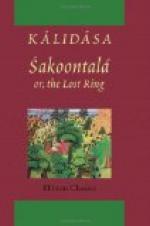131. Saraswati.
She is the goddess of speech and eloquence, patroness of the arts and sciences, and inventress of the Sanskrit language. There is a festival still held in her honour for two days, about February in every year, when no Hindu will touch a pen or write a letter. The courts are all closed accordingly.
132. The purple self-existent god.
[S’]iva is usually represented as borne on a bull; his colour, as well as that of the animal he rides, being white, to denote the purity of Justice, over which he presides. In his destroying capacity, he is characterized by the quality ‘darkness,’ and named Rudra, Kala, etc., when his colour is said to be purple or black. Some refer the epithet ‘purple’ to the colour of his throat; compare note 96. Self-existent, although properly a name of the Supreme Being (Brahma), is applied both to Vishnu and [S’]iva by their votaries.
134. Whose vital Energy.
That is, [S’]iva’s wife, Parvati, who was supposed to personify his energy or active power. Exemption from further transmigration, and absorption into the divine soul, was the summum bonum of Hindu philosophy. Compare note 37.
135. By my divine faculty of meditation.
Celestial beings were endowed with a mental faculty (called dhyana, pranidhana, etc.), which enabled them to arrive at the knowledge of present and future events.
136. A roseate dye wherewith to stain The lady’s feet.
That is, the soles of her feet. It was customary for Hindu ladies to stain the soles of their feet of a red colour with the dye made from lac—a minute insect bearing some resemblance to the cochineal—which punctures the bark of the Indian fig-tree, and surrounds itself with the milky resinous juice of that tree. This custom is a alluded to in one of Paterson’s Hindu odes—
’The rose that humbly bowed to meet,
With glowing lips, her hallowed feet,
And lent them all its bloom.’
See Megha-duta (Edit. Johnson), p. 32.



